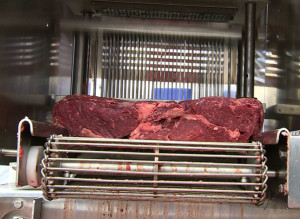Before you bite into your next steak, consider this unappetizing fact: It may have been punctured all over before it made its way to your plate, contaminating the inside of the meat with bacteria that can make you sick.
 As the name suggests, mechanically tenderized beef has been put through a machine that breaks up the muscle fiber and tough connective tissue with blades or needles. This promotional video for the Jaccard Model H Commercial Meat Tenderizer shows just what that looks like (below).
As the name suggests, mechanically tenderized beef has been put through a machine that breaks up the muscle fiber and tough connective tissue with blades or needles. This promotional video for the Jaccard Model H Commercial Meat Tenderizer shows just what that looks like (below).
About a quarter of beef sold in the U.S. has been treated this way. The restaurant industry is one of the largest purchasers of mechanically tenderized beef because the process makes cheaper cuts of beef more palatable and therefore more marketable. Moderately priced cuts – such as sirloin tip, eye of round, inside round and outside round – are more likely to have been mechanically tenderized, according to the beef industry.
After an E. coli outbreak in 2012 prompted the largest meat recall in Canada’s history, the country instituted mandatory labeling of all mechanically tenderized beef that includes safe cooking instructions. In the U.S., Costco started voluntarily labeling such cuts as “blade tenderized” after meat sold in its Canadian stores was implicated in that outbreak.
After years of pressure by consumer groups, the U.S. now is poised to require labeling of mechanically tenderized beef, too. That’s over the objections of the meat industry. But the new rules still might take years to take effect.
